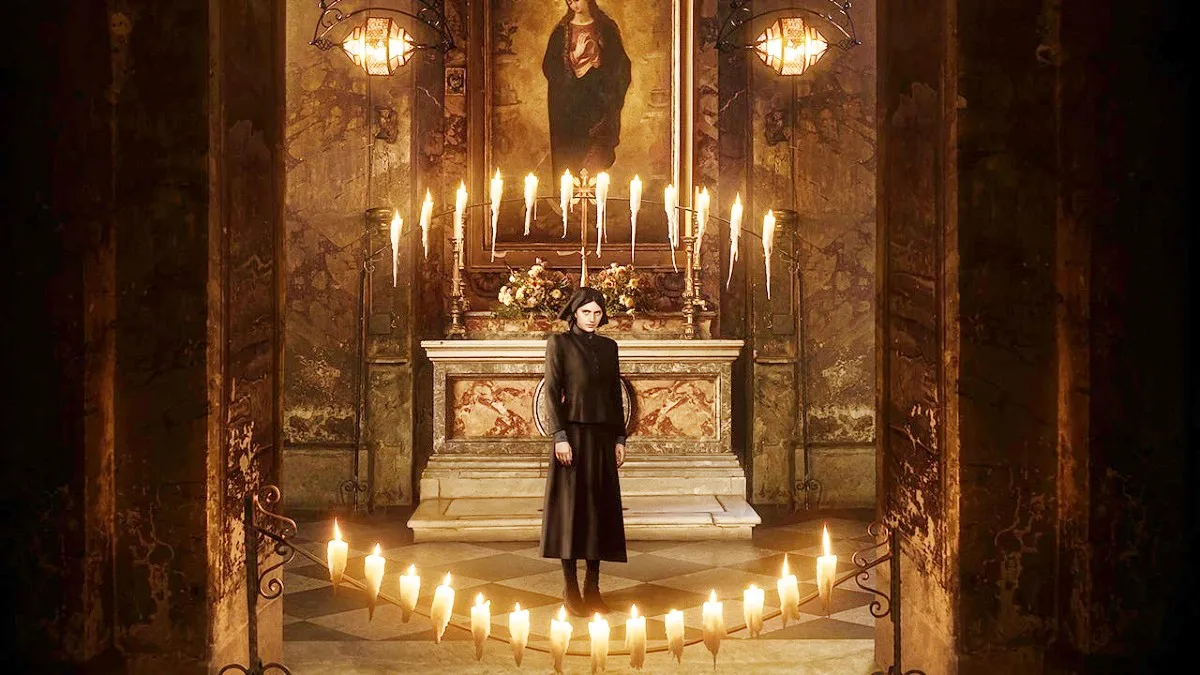
There’s been a lot of focus throughout the entirety of Sherlock, but these season in particular, on Sherlock’s memory palace. It’s the process he uses to recall the pertinent facts of cases as and when he needs them, and until now it’s worked incredibly well. When Mary shoots him in Magnussen’s office, the strength of the memory palace came in to full effect, providing him with the medical knowledge to best sustain his recovery alongside calming memories to negate the effects of shock on his body. It’s never stated, but always taken as read in the show that surely Sherlock has the most well-appointed memory palace in the entire world. Surely he does. How could anyone have anywhere near that level of mental acquity to maintain such a place? Enter Magnussen. We suspect something’s up when Sherlock investigates his ever-present spectacles, only to discover that they’re simple eyeglasses. What had seemed up till then (deliberately) a Google Glass-style technological trick was revealed to not be that at all. I thought perhaps he had eye implants, which would of course be insane, but then I am insane, so it follows. It turns out that the technology he’s using is the good old human brain, not his glasses. The information he has isn’t in paper folders and files, as Sherlock assumed – a human error – but stored away in an incredibly elaborate memory palace.
In a sea of twists, this twist was the twistiest of them all. Not even the final shocker, that Moriarty’s face is being broadcast on every screen in the country and would appear to be back, felt as earth-shattering as Magnussen’s memory palace reveal. It was stunning and, watching the episode back a second time, it still comes totally out of the blue but makes perfect sense. It meant that Sherlock was forced to view Magnussen in a different light, one that perhaps forced them to be in awe of their abilities. This was duplicated nicely in the Watson/Mary story, where Watson – even though he never read the contents of that fateful memory stick full of information (a very different ‘memory palace’), so’s not to colour his opinion of her too much – he was still forced to look at Mary in a whole new way. Her unwitting confession before him did that much.
Sherlock’s assessment of Watson as being addicted to placing himself in dangerous situations with dangerous people was a nod to the legacy of the books, of which Watson is very much the focus. The stories are about Watson, and his relationship to Sherlock, and you might say that while Mary is psychopathic, and Sherlock is sociopathic (or at least autistic), Watson is an addict. This would explain why he got so angry at seeing Sherlock addicted to heroin in the squat at the beginning – perhaps he was subconsciously recognizing the addictive behaviours Sherlock was exhibiting as those he himself has shown before. Who we first thought of as the straightlaced, normal one of the duo might actually be the more deviant, as he is making an active choice to place himself in those situations. Sherlock is compelled without thought, as that is somehow programmed into his behaviour from before he was born. Same with Mary. Watson, however, has chosen to follow war wherever it may happen, and with Moriarty approaching on the horizon, it may come sooner that he thinks.
Random Robservations:
- This episode was ripe with Sherlock nicknames – “Shag-a-lot Holmes”, “Sherl”, “Shezza”, all excellent.
- What the hell could A. G. RA stand for?
- Hopefully revealing that Mary is as damaged as Sherlock and Watson will make the internet hate her slightly less. Why do people hate strong, interesting female characters? I’d happily watch a Mary Watson spinoff.
- Martin Freeman does repressed British anger like no-one else. From Magnussen urinating in the fireplace to being “very bloody annoyed” with Mary, he’s just perfect. A better Watson than Benedict Cumberbatch is Sherlock, I’d say, and I love Cumberbatch’s Sherlock.
- So Sherlock is not afraid to just straight up murder someone to protect Watson. Nice. It was the vow he made – “his last vow” – last episode, I guess.
- After the apparent Boris Johnson-bashing last week, were the Rupert Murdoch references a little on the nose? A foreign media magnate with dirt on everyone, and a very close relationship with the Prime Minister? Anyone? Are Stephen Moffat and Mark Gatiss going out of their way to make powerful enemies? If so, good on them.
References to the novels:
- Bill Wiggins, introduced here as Sherlock’s protege, was the leader of the Baker Street Irregulars in the Conan Doyle canon.
- The entire episode was ‘The Adventure of Charles Augustus Milverton’, slightly redone, and with a much more satisfying ending.
- Watson finding Sherlock on heroin in a squat is akin to Watson finding Sherlock in an opium den in ‘The Man with the Twisted Lip’. That was also for a case.
Well, that’s all for this season. Apparently Sherlock has been confirmed for seasons four and five, so who knows when I’ll see you next. If you have anymore references that the episode made to the short stories/novels, please leave them in the comments! There’s bound to be a few I’ve missed. I’ve had fun reviewing this show, and thanks for reading.






